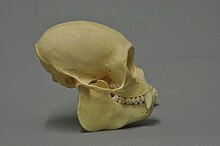Brown woolly monkey
| Brown woolly monkey | ||||||||||||
|---|---|---|---|---|---|---|---|---|---|---|---|---|

A male brown woolly monkey |
||||||||||||
| Systematics | ||||||||||||
|
||||||||||||
| Scientific name | ||||||||||||
| Lagothrix lagotricha | ||||||||||||
| ( Humboldt , 1812) |
The brown woolly monkey ( Lagothrix lagotricha ) is a species of primate living in South America from the family of the spotted monkeys (Atelidae). In the past, all woolly monkeys were grouped into one species, which also bore the scientific name Lagothrix lagotricha , today there are four species.
features
Like all woolly monkeys, brown woolly monkeys are stocky animals with strong limbs and a long tail. The name comes from the thick, woolly fur , which is colored in different shades of brown. The hairless face is dark, the head is rounded, the ears are small. The long tail is designed as a grasping tail. These animals reach a head body length of about 50 to 70 centimeters, the tail is slightly longer than the body. The weight is around 7 to 9 kilograms, with the males being slightly heavier than the females.
distribution and habitat
Brown woolly monkeys live in southern Colombia , the extreme north of Ecuador and Peru and northwestern Brazil - the Amazon forms the southern limit of their range. Their habitat is forests, especially lowland rainforests . They occur up to an altitude of 1400 meters.
Way of life
Like all woolly monkeys, these primates are diurnal tree dwellers that rarely come to the ground. They move either on all fours or swinging and swinging, using the prehensile tail like a fifth limb. Generally speaking, they are skilled but rather leisurely climbers. They live in groups of around 20 to 30 animals that sometimes split up to forage. The groups inhabit huge areas of up to 1100 hectares, but these can overlap with those of other groups. They usually do not react in a hostile manner to foreign groups.
They feed primarily on fruits, they also eat leaves and other parts of plants and occasionally small animals.
After a gestation period of around 225 days, the female gives birth to a single young. This is weaned after around a month and sexually mature at four to six years of age.
Danger
Brown woolly monkeys are relatively widespread and often inhabit remote, sparsely populated areas. However, they are sensitive to human interference and in some places are also exposed to hunting pressure. The IUCN lists them as "endangered" ( vulnerable ).
The species is no longer kept in Europe, former keepers are Cologne, Wuppertal and London. The last European brown woolly monkeys lived in Wuppertal in the 1970s.
literature
- Thomas Geissmann : Comparative Primatology. Springer-Verlag, Berlin et al. 2003, ISBN 3-540-43645-6 .
- Don E. Wilson, DeeAnn M. Reeder (Eds.): Mammal Species of the World. A taxonomic and geographic Reference. Johns Hopkins University Press, Baltimore MD 2005, ISBN 0-8018-8221-4 .
supporting documents
Web links
- Lagothrix lagotricha in the endangered Red List species the IUCN 2009. Posted by: E. Palacios u. a., 2008. Retrieved November 5, 2009.

